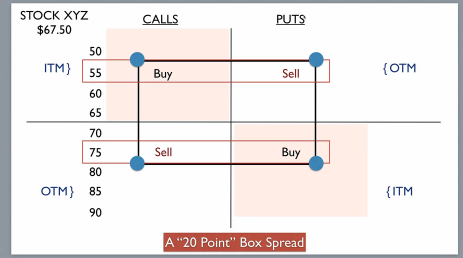Search Options Trading Mastery:
- Home
- Option Spread Trading
- Box Spreads
Box Spreads Illustrated and Explained
Box spreads are an option trading strategy that involves purchasing a bull call spread with a corresponding bear put spread. The two vertical spreads have the same expiration dates and strike prices.
The idea is, that these two vertical debit spreads, each of which is designed to profit when the price of the underlying moves in either direction, create a "box" around the current trading price. A bull call spread normally profits when the underlying moves upwards, while the bear put spread does so when the prices falls.
So if you create two vertical debit spreads which, for want of a better expression, "face each other" on either side of the current market price of the underlying (the puts above and the calls below), you have effectively "boxed in" profits with options.
The thing to remember about debits spread however, is that profits are always limited to the difference in strike prices at expiration date, so the trick is to ensure that the cost of one of the debit spreads is sufficiently cheaper than the other, so that a profit can be realized.
There are times when option contracts are underpriced, usually due to current perceptions about the expected future price movement of the underlying market - for example, whether a trend has been exhausted and a reversal is imminent. So puts might be much cheaper than calls - and this is the ideal time to consider using box spreads. Price distortions create opportunities which are known as "arbitrage".
Most investors use this arbitrage strategy in cases where the spreads are under-priced in comparison to their values at the options expiration dates. The arbitrageur is buying as well as selling equivalent spreads at the same time, on the proviso that the price paid for the box spread is considerably below the combined value at expiration of the spread, in which case a risk-free profit can be immediately locked in.
Expiration Value of the Box = Higher Strike Price less Lower Strike Price in the spread
Risk-free Profit = Expiration Value the of Box is less the Net Premium Paid
Some Assumptions Used in Box Spreads
1. The trader is risk averse
2. The trader prefers more wealth to less
3. Trade only happens in one trading period
4. The transaction and operation costs are zero
5. The investor has the ability to easily enter and exit the market and the market is efficient.
Box Spreads - An Illustration
Suppose ABC stock is currently trading at $45 in December and the current options prices for the month of January are:
JAN 40 put - $2.50
JAN 50 put - $8.45
JAN 40 call - $6.55
JAN 50 call - $5.50
Buying A bull call spread includes purchasing the JAN 40 call for $655 at the same time selling the Jan 50 call for $550.
The bull call spread costs: $655 - $550 = $105
Buying a bear put spread includes purchasing the JAN 50 put for $845 at the same time selling the JAN 40 put for $250.
The bear put spread costs: $845 - $250 = $595
The total accumulated cost of the box will be $105 + $595 = $700
The expiration value of the box is calculated to be: ($50.00 - $40.00) x 100 = $1000.00
Since the total calculated cost of the box spread is much less than the expiration value, a risk-free arbitrage is available with a box strategy implemented. We can observe that the value at expiration of our box spread, is the difference between the strike prices of the options available during the trading period.

If ABC stock price remains unchanged at $45 at expiration date,
then the JAN 40 put as well as the JAN 50 call expire worthless while
both the JAN 40 call as well as the JAN 50 put expire in-the-money with a
$500 intrinsic value each. Therefore, the total accumulated value of
box at the date of expiration is: $500 + $500 = $1000.
Alternatively, suppose on the date of expiration in January, ABC stock price rallies to $50,
so that only the JAN 40 call expires in-the-money with $1000 intrinsic
value. Therefore, the box will still worth $1000 at the date of
expiration.
What will happens when ABC stock plunges to $40?
The same situation occurs but this time, it is the JAN 50 put which
expires in-the-money with $1000 in intrinsic value while all the other
available options will expire worthless. Remember still, the box spread
is worth $1000.
As the trader you have only paid $700 for the
whole box, so your profit will be $300 regardless of where the
underlying asset's price action is at expiration date.
Once you find these opportunities, you can just set and forget them.
For more on Box Spreads and their very appealing cousin, the Three Legged Box Spread, read this article.
***************** *****************
Return to Option Spread Trading Contents Page
Go to Options Trading homepage














New! Comments
Have your say about what you just read! Leave me a comment in the box below.